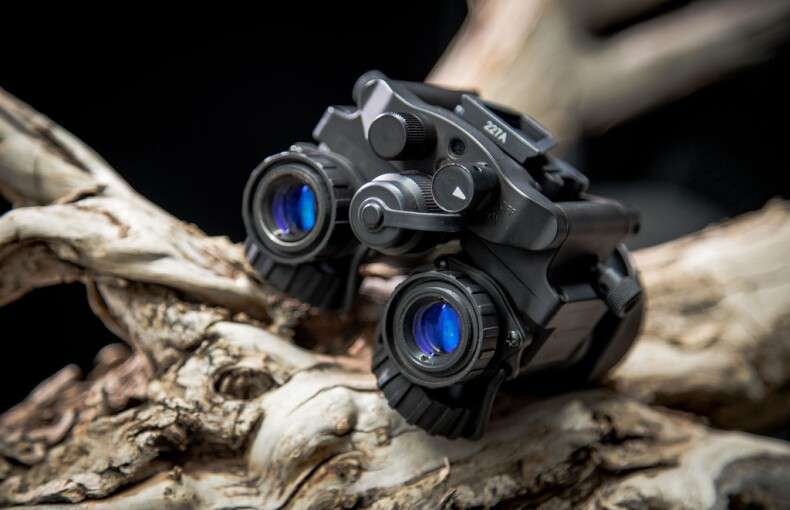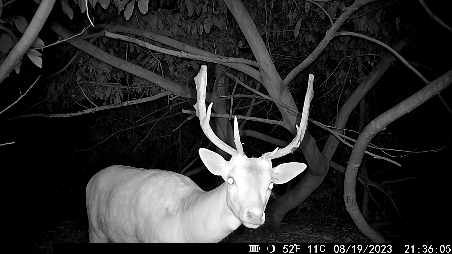Professional ecologists, researchers and wildlife documentary filmmakers often use night vision devices (NVDs) to observe and record nocturnal activity. Badgers, foxes, deer, owls and bats are all common across the UK, and footage of these elusive creatures is both fascinating and informative.
Buying night vision equipment puts us up against complex specifications, comparing digital vs analogue night vision, and deciding what functions are most important for our purpose. Whether you’re investing in night vision equipment for research or choosing a night vision camera to observe local wildlife, this guide will spell out the complexities and help you decide.
Night vision technology amplifies the available light in the environment and produces an image for the user to see. Nocturnal animals’ eyes dilate in the dark, letting in more light and helping them see. In the same way, night vision equipment collects even tiny amounts of light, such as starlight, and amplifies it to generate an image that human eyes can understand.
There are two main types of Night Vision: Analogue and Digital.
Traditional analogue night vision relies on a device called an Image Intensifier Tube (IIT). This is a system of optical lenses and an electronic vacuum tube.
The glowing phosphor is why analogue night vision produces a green image.

We offer an analogue night vision binocular system in the AGM NVG-50 from Echo, which uses Gen 2+ image intensifier tubes to create a clear image.
One advantage of analogue night vision is that it uses much less power than digital night vision: the AGM NVG-50 requires a single AA battery providing 20 hours of use.
Today, most night vision technology uses less chemical means and more computer technology. Digital image enhancement in night vision uses a digital sensor to detect light. A computer processor enhances the light and renders a clear image on the LED display screen, which is viewed through the eyepiece.
High-end digital night vision systems can render colour images, record video and photography and use digital zoom to get a close-up look.
As you investigate the different night vision devices available, consider these specifications to find the best option for your needs. Think about how you intend to use the equipment, whether for research or wildlife spotting as a hobby.
The field of view is the angle your lens covers on a horizontal plane. Night vision devices typically have a narrow field of view close to 40o.
When zooming or magnifying, the FOV gets narrower to focus on a point further ahead.
Make sure the device has a long enough battery life for your purposes. Some NVDs use AA batteries, such as the analogue AGM NVG-50 AP Dual Tube, while others use rechargeable batteries, such as the SiOnyx Aurora Pro.
The viewing range is the furthest distance at which you can see and distinguish objects using the device. A low-end NVD will typically have a viewing range of around 200m, while more high-end models can achieve viewing ranges of up to 500m.
Most night vision equipment comes with an Infrared (IR) illuminator, which provides additional light in extremely dark conditions. This device emits infrared light at such a long wavelength that it is invisible to the human eye. The camera can detect the infrared reflecting from objects in the area, and create an image with the appearance of illumination.
IR illuminators are also commonly used in night vision binoculars and wildlife cameras. They allow the user to see in complete darkness without disturbing nocturnal creatures.
If you’re comparing optoelectronic night vision equipment, you should also look out for the following specs. Their inclusion is dependent on the manufacturer, so not every product will list all of these metrics, but where present they can be useful indicators of value.
The figure of merit (FOM) is a value that marks the performance and quality of the image intensifier tube. Mostly used by US manufacturers, the FOM represents the relationship between the signal-to-noise ratio (S/N) and the resolution (lp/mm).
The highest FOM values are around 2000, such as the AGM NVG-40 AP Echo. FOM of 1600 indicates a good quality tube that will generate a clear image.
When comparing digital night vision devices, the features commonly found on digital cameras and other optics apply. It is worth considering the following when choosing digital night vision.
Zooming in on scenes can offer greater detail and a more accurate understanding of animal behaviour. While optical zoom adjusts the distance between the lenses, digital zoom enlarges an area of the image. This can magnify far further than optical lenses, with some NVDs offering up to 8x digital zoom. However, optical zoom will always give a clearer image than digital zoom.
The higher the resolution, the better the image will be. Resolution is the number of pixels on the display screen and is usually presented by length and width, or in terms of total pixels.
Nocturnal wildlife behaves very differently from diurnal (daytime) wildlife. With night vision, you can witness and record these behaviours and gain a deeper understanding of the species you seek. For this reason, night vision is considered a key tool in wildlife ecology studies where night-time observations are required.

Night vision spotters can illuminate your whole surroundings to show the details of the habitat, and more characteristics of the wildlife at a distance. Because night vision uses light rather than heat, the plumage patterns and fine features of nocturnal creatures are made visible in ways that thermal imagers can’t reproduce.
When observing wildlife after dark, using a torch to light your way can affect your results: the light disturbs creatures and warns them of your presence. However, moving around in the dark is hazardous.
Night vision equipment can help you identify holes or obstacles in the area without creating disruptive light.
Improve visibility at night and understand your nocturnal ecosystem. By understanding and comparing the available features of different night vision equipment, you can make an informed and confident decision.
Buy Night Vision Devices Online
At Wildlife Cam, we stock a wide range of digital and analog NVDs for nocturnal wildlife observations. We work with well-known optics brands such as Sightmark, AGM and SiOnyx to provide high-quality night vision equipment. For any further questions about our products or deliveries, Contact Wildlife Cam or Search our FAQs for more support.

WildlifeCam Ltd is a credit broker, not a lender, and is authorised and regulated by the Financial Conduct Authority No 997540
We do not charge for credit broking services, we introduce you exclusively to Klarna
Shop and pay the Klarna way - join 150 million customers and choose flexible payments, lightning-fast checkout and secure shopping at WildlifeCam Ltd.
For more information please click here.